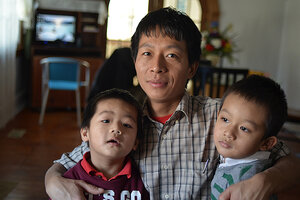For small-town America, new immigrants pose linguistic, cultural challenges
A new generation of immigrants is arriving in Midwest towns from far-flung places such as Myanmar, Somalia, and Iraq. The communities are trying to adjust.

Thwang Lin, who works the second shift at the JBS USA pork processing plant in Marshalltown, Iowa, is at home with his two boys, Jan. 23, 2015. The younger boy, in the burgundy sweat shirt, is Augustine, and the older one is Johnson.
RICHARD MERTENS
Marshalltown, Iowa
The voice was frantic – and unintelligible to the 911 dispatcher. “Ma’am, I cannot understand you,” she said. After 80 seconds, one word leapt out: “Riverview.”
On a warm July evening in 2012, while Marshalltown, Iowa, celebrated Independence Day, three refugee children from Myanmar (Burma) drowned in the Iowa River. The drownings at Riverview Park cast a grim light on the challenges facing both the city and its newest immigrants, most of whom spoke little English and had scant understanding of life in their new home – including the perils, known to more established residents, of the river’s treacherous currents.
“We preach to kids all the time: You don’t swim in the river. You don’t play around the river,” says Kay Beach, president of the Marshalltown school board. “But they didn’t know that.”
For two decades, rural communities across the Midwest have been finding ways to absorb Latino immigrants. Now, a new generation of immigrants arriving from far-flung places such as Myanmar, Somalia, Iraq, and West Africa has brought a bewildering variety of cultures and languages. Many towns are struggling to cope.
Experts say the changing face of immigration in the rural Midwest reflects stricter federal enforcement. Tighter border security has slowed the influx of immigrants from Latin America entering the United States illegally. Meanwhile, the meatpacking industry has looked to refugees, who enjoy legal status, as a way of avoiding problems with undocumented Hispanic workers.
Much of the difficulty surrounding the new immigration is linguistic. Language barriers complicate services from law enforcement to health care. Ms. Beach recalls a school expulsion hearing that required two interpreters – the first to translate from one dialect of Myanmar to another, the second to translate into English.
Cultural differences can cause problems, too. “Back where we come from, people used to live how they want,” says Nyein Pay, who was a guerrilla fighter against the Burmese government and now cuts pork at a local meatpacking plant. “We used to grow up in the forest. Here we live in a city. It’s different. Here they have tight laws.”
Communities are trying to adjust. After the Marshalltown drownings, the schools and the local YMCA organized swimming classes. In Columbus Junction, Iowa, the town started a community garden for immigrants from Myanmar; the local health clinic hired an interpreter.
Mallory Smith, director of the Columbus Junction Community Development Center, says police have grown experienced at dealing with language barriers. “You know when you’ve got to use sign language, to use simple words, to draw a picture, or get a translator.”

